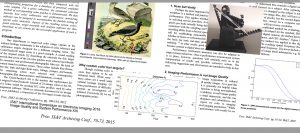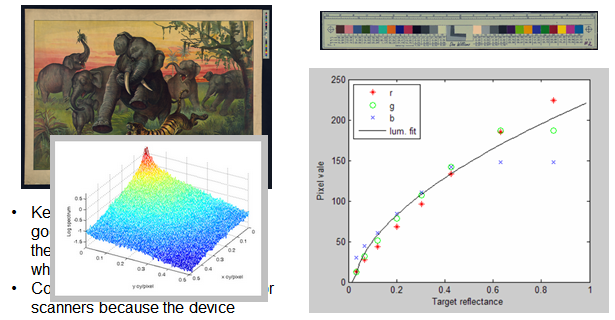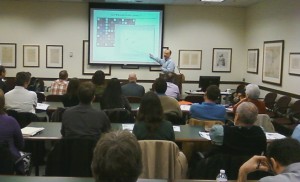No, this is not about KPIs or archery. Upon landing at San Francisco we saw what appeared to be, surveillance camera calibration targets.
This video is the result – based on a true story.

When I was at the Electronic Imaging Conference in San Francisco in February there was a man with a parrot attending. He walked around with it and brought a cage to the conference rooms when he was attending. On the last day of the conference, I was near the back of a room where a speaker was being introduced. The parrot said ‘Hello!’ and it resonated. Everyone turned around for a second then the session continued.
Leaving the room later, I passed the parrot in his cage (he had been taken there by his owner). I talked to the parrot to see if I could record it, but no luck. I just got a squawk.
Later I imagined a BBC radio story, The Parrot at the Conference (audio).
Recently the UK Royal Mint issued a set of ten-pence coins, the A to Z 10p Collection. Below is part of a picture posted by Sharon Henley, head of Marketing at the Mint. Preparing for the Archiving conference (#Archiving2018) next month, this got me thinking about old and new coin circulation. Those we keep and those that return, sometimes unnoticed, after our travels.
First, I am not a collector but I do find stamps and coins interesting. Coin designs are usually meant to celebrate, document, or at least note, the issuer’s history, culture and government in a serious way. The A to Z 10p Collection coins are quite different. They celebrate things British that are both unique and common-place. They are angelic, monstrous, sporting, double-deckered, full-English, ‘henged, oaked, parliamentary, artistic, and the rest.
Please note these are serious matters, and by all accounts the collection is highly successful.
Well, in our private coin ‘collection’ (stored for random-access in dresser drawers) we have quite a few coins from quite a few places. Checking the countries and dates, it is easy to discern an approximate record of family travels. Having extended-family members (whom I have visited) in five countries, and traveling rellies results in a fairly wide net. An approximate sampling of time and place.
Those from the UK show a few that were in circulation when we emigrated, just prior to conversion to decimal currency (1971). Some are much older, of course, and represent the random, or ‘interesting because they are old’ group. Two 1919 pennies are probably from Grandpa. However the 1945 half-penny was recently given by local friend, but could not resist including it. My more recent visits to England are also represented.
We also have Panamanian Bolivars and Australians pennies (and cents), alongside our neighbours’ Mexican pesos and Canadian loonies. Then there are the others,
We found lots of others of course, but then …. maybe I am a collector – of connections to family, colleagues and friends, via the things that end up at home. Bet you have few too.
– Peter Burns
_____
p.s. The Union Flag (I think) is one that was sewn on a backpack that traveled through Europe with my younger brother as a university student. Wonder if he wants it back.
We had all heard that Tito helped the Smithsonian Institution’s research station on an island in Gatun Lake, Panama. My father-in-law, Ismael Olivares, a Kodak man, started his career in his native Panama at their Tropical Labs. A chemist, he became an authority on the preservation and restoration of film products in tropical climates. The primary problem was fungus growth.
Barro Colorado is an island formed when Gatun Lake was created as a water supply for the operation of the canal. The island, thus provided a preserved habitat. In 1924 a natural history lab. was founded. This would later become the Smithsonian Tropical Research Institute.
The photo shows Barro Colorado Island Lab. buildings and dock from Gatun Lake. The tramway to the top of the island is visible.
It was the 1960s and sometimes on Saturdays he and his eldest daughter (and my connection to the family) would visit the island. She remembers these pleasant boat trips to the island, with its Howler Monkey calls in the tropical forest, wandering tapirs, and iguanas taking in the sun.
Descriptions of all this have been aided over the years by photographic slides, projected after family get togethers. Many of the colored photos have faired well, but several have not (although in fairness, they may have been experimental rather than product films).
Well, Tito no longer needs the house, and it naturally fell to the family to clean things up for selling. A common story of a family’s accumulation in a home of fifty-plus years. Among the old textbooks, pre-prints from his articles (a form of pre-PDF personal archiving for publishing scientists), and patents, was a poster with a picture of two Australian aboriginal men.
Actually, what I saw first was an inscription from the photographer on the folded back of the poster. He thanked Tito for his help with fungus on his film negs.
Mr. Olivares,
I want to thank you for all your help with the problem of fungus on my film. It was you more than anyone else who made the present show possible. I am very grateful for what you did.
RSM
The photographer, Roger Manley, presented ‘Sullen Landscape, Australia Photographs’ in 1979 at the Davidson College Art Gallery, Davidson, North Carolina. Manley studied at Davidson College, after he had spent two years living in the Australian outback with an Aboriginal* tribe. He is currently the director of the Gregg Museum of Art & Design at North Carolina State University.
Manley’s gracious note, the photos of Barro Colorado, and Tito’s subsequent visits to the Smithsonian in Washington are reminders of the contributions made by this industrial scientist.
In the modern era, I would expect to see the results of such consulting to be more widely known. Perhaps described at IS&T conferences, and local university seminars. I have found such external (non-proprietary) projects, whether for institutions, international standards, or as adjunct faculty, have complemented my primary work. Spice of life, don’t you know.
– Peter Burns
____________
* Aboriginal and Torres Strait Islander Peoples
P.S. Tito was a member of IS&T, and published in the society journals.
Update: Tito passed away without pain last Sunday, 20 Oct. 2019, with family. He had recently turned 93.
Goodbye, Tito, and may we all aspire to be Buena Gente (kind people).
I attended the 2+3D Photography – Practice and Prophecies conference in May, held at the Rijksmuseum in Amsterdam.
Here is a video postcard, courtesy of Google Photos. The photos are largely unedited, some captured on film. The audio was recorded while walking around with my mobile phone, with simple editing also.
Here is the link to the two-minute video. This will open in Google Photos – when it opens, CLICK to hear audio.
Recently, the material for many of the conference presentations was posted.
For those who attended the IS&T Archiving Conference last month, here is a souvenir postcard-video, courtesy of Google Photos. The photos are largely unedited, and are from my analogue (film) and digital cameras. Many of you will notice the different ‘look’.
The audio was capture while walking around with my mobile phone, with simple editing also.
Here is the link to a 2 min. video. This will open in Google Photos – when it opens, CLICK to hear audio.
 English language version – Todas las fotos tomadas en el día
English language version – Todas las fotos tomadas en el día
El tema de un reciente programa de radio Latino USA fue el Tucson (Arizona) Rodeo, también conocido como La Fiesta de Los Vaqueros. Escuchar la historia de la familia y la competencia de sus 8 años me recordó una gran experiencia que tuve al asistir a la primera Conferencia de Archivos de IS&T en San Antonio, Texas. Esta serie de conferencias anuales continúa, y el próximo mes estaremos en Riga, Letonia.
Estábamos en San Antonio un par de días antes de la conferencia, e interesado en asistir a un servicio de iglesia mariachi domingo. En consejo de nuestro hotel, fuimos a Mission San José iglesia, 15 min. lejos. Disfrutamos de la música mariachi y masa en español. Durante los anuncios al final un artículo me llamó la atención. Una Charrería, debía celebrarse más tarde ese día cerca. No saber mucho acerca de esta exhibición local / competencia de equitación, decidimos verlo.
Charrería
Charrería, o charreada, ha sido descrito como el abuelo del rodeo. Se originó con el español en América. Charros, jinetes mexicanos, adaptó las competiciones ecuestres de los españoles para producir un deporte exclusivamente mexicano. Se convirtieron en celebraciones para las comunidades, y las ocasiones de fin de semana para reunir a la familia y amigos.
Después de un par de giros equivocados (navegación por mapas impresos en ese entonces), encontramos la arena circular, con asientos de 7-8 asientos altos. Entrada sin pavimentar, polvorienta – ambiente organizado y amigable – caballos, y competidores en traje tradicional.
Recuerdo pensar que, aunque la congregación en la masa parecía ser alrededor del 30% turistas-visitantes (cámaras, libros de viaje), esta multitud parecía ser principalmente locales. Y qué lujo fue!
Impresiones de memoria,
Aprendimos sobre las misiones y el desarrollo temprano de la Hispanoamérica ese día, pero lo que más recuerdo es la diversión en la Charrería. (Para mí, las chicas jóvenes que aparecen abajo robaron el espectáculo – Preciosas!)
El curso corto y el presentación de nosotros en la primera conferencia de IS&T Archiving fue bastante bien también. Además, las imágenes de cámaras digitales de consumo proporcionan una buena medida de las mejoras que a menudo damos por sentado.
Hay cosas aprendidas en el camino

While attending recent imaging conference, a friend told me about a recent website posting on a topic familiar to me. We had previously discussed some of the normal levels of permission needed for posting by this US government cultural institution, so it was good to see. The posted information included software and links to supporting documents, including a paper presented at a conference I had attended.
I checked the links to the software file, manual and conference paper which reported on the method used. All links intact – good so far. However, when I viewed the posted version of the published conference paper something important was missing, the original publication, date, etc. Later, checking on other posted conference papers, I found several more examples.
Background: Many conferences* publish books, e.g. Proceedings of Annual River Wideners Conf. 1972. These proceedings books are published and copyrighted by the organizing society or group. In some cases, the authors are allowed to post their conference articles on their own websites. I am only addressing such permitted posting.
Posting: Back to the example I was looking at. The institution’s webpage had a link to the posted article (a PDF File). The hypertext was the article’s title only. The version of the posted article, however, had no indication of where or when it had been presented or published – reducing the chance that others would cite it in their publications.
Newspapers (please …) normally have a header that tells the reader the publication they are reading. This is often called the nameplate. Academic journals also have this in either a page header or footer, with page number etc.
Include reflexive citation: So if you are posting your published contributions online, increase the chance for others to read and cite your work by adding a reflexive citation in the header or footer. You probably uploaded a version for the proceedings book that did not have this information because pagination and such is done when assembling the book. Just add the citation to your version – you have the original (word processor) file.
There is probably another term for this. I am reminded of those reflexive verbs and pronouns we learnt when studying foreign languages (e.g., I feed myself /Je me nourris, I see myself / Yo me veo, or is it just, me veo) that we were unaware of in our native tongue. But we can teach ourselves … no?
File under: RefCit
_____
* While I am generally not in favour of including gratuitous pictures of AE in social media, this one seems appropriate, being from a famous conference on physics in 1927. Authors from this conference did not post their papers on-line, so did not need to add a reflexive citation.
 EI02: Introduction to Image Quality Testing: Targets, Software, and Standards
EI02: Introduction to Image Quality Testing: Targets, Software, and StandardsShort Course at IS&T’s Electronic Imaging Symposium, San Francisco 29 Jan. 2017
Instructors: Peter Burns, Burns Digital Imaging, and Don Williams, Image Science Associates
8:00 – 10:00 AM (2 hours)
Course Level: Introductory
Fee: Member fee*: $165 / Non-member fee: $195 / Student fee: $60 *(after January 9, 2017 prices for all courses increase by $50, $25 for students). To register for symposium and/or short course. Early registration date, 9 Jan. 2017.
An introduction to imaging performance evaluation for image capture, providing a foundation for more advanced topics, e.g., system characterization and performance benchmarking. We adopt a scenario-based approach by describing several situations where imaging performance needs evaluation. Each of these, from design to quality assurance for manufacturing, is addressed in terms of suggested methods, color test charts, and standard reporting. For several important attributes, we describe international standards, guidelines, and current best practice. Examples are drawn from various applications, including consumer, museum, mobile, and clinical imaging. We will help participants to;
Intended Audience: This course is intended for a wide audience: image scientists, quality engineers, and others evaluating digital camera and scanner performance. No background in imaging performance (optical distortion, color-error, MTF, etc.) evaluation will be assumed.
 Instructors: Peter Burns is a consultant working in imaging system evaluation, modeling, and image processing. Don Williams is founder of Image Science Associates. Both are frequent presenters at technical imaging conferences.
Instructors: Peter Burns is a consultant working in imaging system evaluation, modeling, and image processing. Don Williams is founder of Image Science Associates. Both are frequent presenters at technical imaging conferences.
Information on all EI 2017 Courses
_______________________________________________________________________________________
NOTE: Students who register for EI before the early registration deadline receive one complementary short course with their symposium fee.
![]() Coming up at the end of January IS&T’s Electronic Imaging Symposium 2017. Having participated in the organising and presented over the years, the meeting provides a an opportunity to connect with a rather large group of friends, former colleagues, and clients. The meeting includes several tracks of 2-3 day topical conferences, spanning a wide range of interests. I participate mostly in the IQSP Conference – chairing a session on Tuesday, 31 Jan.
Coming up at the end of January IS&T’s Electronic Imaging Symposium 2017. Having participated in the organising and presented over the years, the meeting provides a an opportunity to connect with a rather large group of friends, former colleagues, and clients. The meeting includes several tracks of 2-3 day topical conferences, spanning a wide range of interests. I participate mostly in the IQSP Conference – chairing a session on Tuesday, 31 Jan.
Image Quality and System Performance Conference (IQSP): Our sessions are described here.
Short Courses:
Don Williams and I will be presenting a short course, Introduction to Image Quality Testing: Targets, Software, and Standards on 29 Jan. 2017. We introduce imaging performance evaluation and provide a foundation for more advanced topics, e.g., system characterization and performance benchmarking.
Our two-hour course is intended to complement other courses held later in the day;
Consider joining us in San Francisco.
– Peter Burns